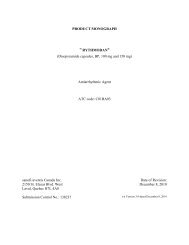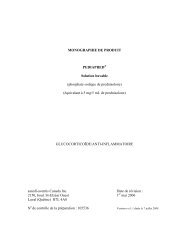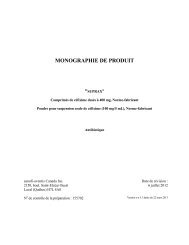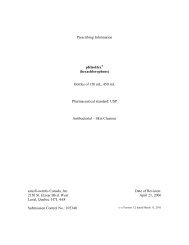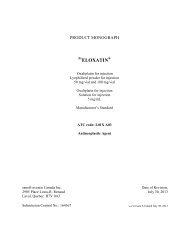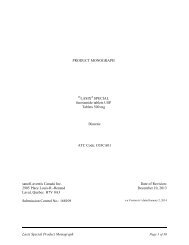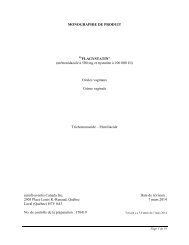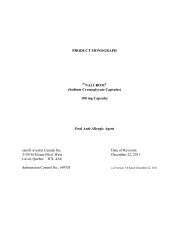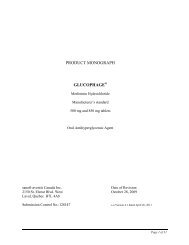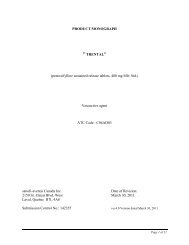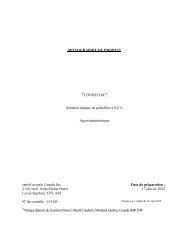Suprefact Depot (buserelin) - Sanofi Canada
Suprefact Depot (buserelin) - Sanofi Canada
Suprefact Depot (buserelin) - Sanofi Canada
You also want an ePaper? Increase the reach of your titles
YUMPU automatically turns print PDFs into web optimized ePapers that Google loves.
Drug interactions:During treatment with <strong>buserelin</strong>, the effect of antidiabetic agents may be attenuated [see alsoADVERSE REACTIONS].Co-administration of androgen deprivation therapy with medicinal products known to prolongthe QTc interval or to induce torsades de pointes should be carefully evaluated. Such medicinalproducts include but are not limited to the examples that follow: Class IA (e.g. quinidine,disopyramide), Class III (e.g. amiodarone, sotalol, dofetilide, ibutilide), or Class IC (e.g.flecainide, propafenone) antiarrhythmic medicinal products, antipsychotics (e.g. chlorpromazine),antidepressants (e.g. amitriptyline, nortriptyline), opioids (e.g. methadone), macrolide antibioticsand analogues (e.g. erythromycin, clarithromycin, azithromycin), quinolone antibiotics (e.g.moxifloxacin), pentamidine, antimalarials (e.g. quinine), azole antifungals, 5-hydroxytryptamine(5-HT3) receptor antagonists (e.g. ondansetron), and beta-2 adrenoceptor agonists (e.g.salbutamol).ADVERSE REACTIONSThe adverse effects observed in patients treated with SUPREFACT DEPOT 2 months orSUPREFACT DEPOT 3 months are, principally, directly related to its anticipated pharmacologicaction, i.e. suppression of pituitary (gonadotropin) and gonadal (testosterone) hormoneproduction with resulting clinical signs and symptoms of hypogonadism (hypoandrogenism).An early in treatment transient increase in serum testosterone levels usually occurs. Occasionally,this may be associated with transient worsening of clinical status and secondary reactions suchas: occurrence or exacerbation of bone pain in patients with bone metastases, signs ofneurological deficit due to tumour compression, impaired micturition, hydronephrosis,lymphostasis or thrombosis with pulmonary embolism. This transient initial rise in serumandrogen will be followed by a progressive decrease to castration levels. [See WARNINGSand PRECAUTIONS].In patients treated with SUPREFACT DEPOT 2 months or SUPREFACT DEPOT 3 months,such reactions can be avoided when an antiandrogen is given concomitantly in the initial phaseof <strong>buserelin</strong> treatment [see PRECAUTIONS]. Some of these patients may, nevertheless, developa mild, transient increase in tumor pain and a deterioration in general well-being.Very rare cases of pituitary adenomas were reported during treatment with LH-RH agonistsincluding <strong>buserelin</strong>.SUPREFACT DEPOT 2 months and SUPREFACT DEPOT 3 monthsNo serious clinical flare reactions were reported in patients (n=379) enrolled in clinical studieswith SUPREFACT DEPOT 2 months and SUPREFACT DEPOT 3 months.8
The following table provides a listing of adverse reactions, incidence ≥1%, considered to be atleast possibly or probably related to <strong>buserelin</strong> acetate implant during a 5 year study withSUPREFACT DEPOT 2 months and a single dose, 16 week study with SUPREFACT DEPOT 3months. Both studies were non-comparative, open label studies.Listing of Adverse Reactions (at least possibly or probably related), Incidence ≥1%Adverse EventSUPREFACT DEPOT2 months(<strong>buserelin</strong> acetate implantequivalent to 6.3 mg of<strong>buserelin</strong> base)Multidose 5 year studyN=299SUPREFACT DEPOT 3 months(<strong>buserelin</strong> acetate implant equivalent to 9.45 mgof <strong>buserelin</strong> base)*Single dose 16 week studyN=22cyproterone acetate+ BuserelinBuserelin ( > 1 weekafter cyproteroneacetate intake**)n %n %n %Hot flashesLibido decreaseHypertensionDepressionPainImpotenceInjection Site ReactionEdemaAstheniaMyalgiaArthralgiaIncreased appetiteInsomniaNauseaPalpitationDizziness47 15.77 2.36 2.06 2.05 1.75 1.74 1.33 1.0< 1.0%------< 1.0%-------- Not detected as at least possibly or probably related* Cyproterone acetate given from 1 week before until 4 weeks after <strong>buserelin</strong> injection.** > 1 week after discontinuation of cyproterone acetate5 22.7-- --2 9.1-- ---- --5 22.71 4.5-- --3 13.61 4.5-- ---- --1 4.51 4.51 4.51 4.53 13.61 4.51 4.5-- ---- --2 9.1-- ---- --3 13.61 4.51 4.51 4.5-- ---- ---- ---- --Other adverse reactions, arranged by body system, and, at least possibly or probably related tothe administration of SUPREFACT DEPOT 2 months or SUPREFACT DEPOT 3 months(individual signs/symptoms occurred at an incidence of less than 1%) were:Body as a whole: Non-serious clinical flare reaction, asthenia, feverCardiovascular system: Heart failure, tachycardia, thrombophelebitisDigestive system: Constipation, fecal incontinence, nauseaEndocrine system: Exacerbation of pre-existing diabetes mellitus, hyperglycaemiaMusculoskeletal system: muscle cramps, myopathyMetabolic and nutritional disorders: Weight gain, weight lossNervous system: Hyperalgesia, nervousness, sleep disorder (insomnia), suicide attempt,sweating increased9
Respiratory system: Dyspnea, pharyngitisSkin and appendages: Gynaecomastia, injection site haemorrhage, pruritus, rashSpecial senses: Blindness in one eye (temporary)Urogenital system: Abnormal ejaculation, male genital pain, urogenital disorderHaemic and Lymphatic: Myeloid metaplasiaArthritis, eye disorder, eczema, headaches, thrombosis and palpitations have been reported asremotely related to the administration of SUPREFACT DEPOT 2 months or SUPREFACTDEPOT 3 months.MISCELLANEOUSIn the literature and in our international database, other adverse events, including events whichwere observed only in females (excluding female gender-specific events) or for other unlabelledindications, have been observed in patients treated with <strong>buserelin</strong>, as itemized below (not allevents were considered to be related to <strong>buserelin</strong> therapy):Digestive system: Changes in appetite (e.g. anorexia), increased thirst, vomitingEndocrine disorder: atrophy of the testesHaemic and lymphatic system: Leukopenia, thrombopeniaLaboratory values: Changes in blood lipids (e.g. hypercholesterolemia, hyperlipidemia),increase in bilirubin levels, increase in serum liver enzymes levels (e.g. transaminases)Musculoskeletal system: The use of LHRH-agonists may be associated with musculoskeletaldiscomfort and pain (including shoulder pain/stiffness in women). It may be associated withdecreased bone density and may lead to osteoporosis and an increased risk of bone fracture. Therisk of skeletal fracture increases with the duration of therapy.Nervous system: Concentration and memory disturbances, dizziness, drowsiness, emotionalinstability, feelings of anxiety, mood changes, nervousness, tirednessSkin and appendages: Articular pains, irritation of the mucosa in the nasopharynx due to nasalsolution administration (which may lead to nosebleeds, hoarseness, disturbances of smell ortaste), rhinorrhea, skin reaction (wheal) allergy, changes in scalp and body hair (increase ordecrease)Special senses: Eye dryness and irritation, feeling of pressure behind the eyes, impaired vision(e.g. blurred vision), hearing disorders, tinnitusSYMPTOMS AND TREATMENT OF OVERDOSAGEThere have been no clinical reports of acute overdosage with SUPREFACT DEPOT 2 months orSUPREFACT DEPOT 3 months.From acute studies of <strong>buserelin</strong> acetate in rodents, neither 0.5 mg/kg/IV (mouse) nor 1 mg/kg/IV(rat) produced evidence of toxic signs.10
Two groups of 6 and 4 healthy volunteers, aged 26-40 years and 31-40 years respectively, weregiven 1 mg <strong>buserelin</strong> or 5 mg <strong>buserelin</strong> orally as a single dose. No LH or FSH release wasobserved. No clinical effects were observed.For management of a suspected drug overdose, contact your regional Poison Control Centre.DOSAGE AND ADMINISTRATIONSUPREFACT DEPOT 2 months and SUPREFACT DEPOT 3 months is intended for thelong-term treatment of prostatic carcinoma. SUPREFACT DEPOT 2 months and SUPREFACTDEPOT 3 months should be administered at approximately equal time intervals to ensure that thedesired therapeutic effect is maintained.The applicator containing the implant rods should be kept horizontal before injection [SeeINSTRUCTIONS FOR USE]. Before injection, a local anaesthetic may be used if desired.SUPREFACT DEPOT 2 months (<strong>buserelin</strong> acetate implant)The contents of one applicator, consisting of two implant rods, equivalent to a total of 6.3 mg<strong>buserelin</strong> base is injected subcutaneously every two months into the lateral abdominal wall. It isimportant to maintain a regular, two-month rhythm for the dosage interval. In exceptionalcases, the dosage interval may be shortened or extended by a few days.SUPREFACT DEPOT 3 months (<strong>buserelin</strong> acetate implant)The contents of one applicator, consisting of three implant rods, equivalent to a total of 9.45 mg<strong>buserelin</strong> base is injected subcutaneously every three months into the lateral abdominal wall. It isimportant to maintain a regular, three month rhythm for the dosage interval. In exceptional cases,the dosage interval may be shortened or extended by a few days.Initial antiandrogen comedication:About seven days before the first injection of SUPREFACT DEPOT 2 months or SUPREFACTDEPOT 3 months, an antiandrogen should be administered in accordance with themanufacturer's directions. This comedication is to be continued for four weeks after the firstSUPREFACT DEPOT 2 months or SUPREFACT DEPOT 3 months injection, when testosteronelevels can be expected to have entered the surgical castration range.11
INSTRUCTIONS FOR USESUPREFACT DEPOT 2 months (<strong>buserelin</strong> acetate implant)andSUPREFACT DEPOT 3 months (<strong>buserelin</strong> acetate implant)INSTRUCTIONS FOR USING THE APPLICATORPlease note: To prevent the implant rods from falling out of the injection needle, hold theapplicator in a vertical position until immediately prior to puncture, with the needle pointingupwards.1. After removing the applicator from the foil wrapping, check that the implant rods are locatedin the window of the handle. If necessary, tap the protective cap of the needle lightly toreposition them in the window.2. Disinfect the injection site of the lateral abdominal wall and administer a local anaesthetic, ifdesired. After removing the protective case from the plunger (E), remove the cap from theinjection needle (B).3. Lift a fold of skin and insert the needle approximately 3 cm (somewhat more than 1 inch) intothe subcutaneous tissue, with the tip of the needle pointed slightly upwards. Withdraw theapplicator about 1 to 2 cm prior to injection of the implant rods.12
4. While fully depressing the plunger, inject the implant rods into the subcutaneous tissue.Compress the puncture channel while withdrawing the needle so that the implant rods areretained in the tissue.5. When the plunger is completely inserted to its final position (plunger knob is touching thebody of applicator), the front end of the plunger protrudes the top of the cannula, protectingthe needle and minimizing the risks of needle stick injuries.6. To ensure that the implant rods have been injected, check the tip of the plunger to see if it isvisible at the tip of the needle.A - Needle; B - Protective cap of needle; C - Plunger; D - Implant rods; E - Protective cap ofplunger.13
PHARMACEUTICAL INFORMATIONDRUG SUBSTANCEProper name:Buserelin acetate (USAN)Chemical name:5-oxo-L-prolyl-L-histidyl-L-tryptophyl-L-seryl-L-tyrosyl-O-tert-butyl-D-seryl-Lleucyl-Larginyl-L-proline-ethylamide-acetateor[D-Ser(Bu t ) 6 ]-des-Gly-NH 2 10 -LH-RH ethylamide-acetateStructural formula:Molecular weight: 1299.5Molecular formula: C 62 H 90 N 16 O 15Physical form:Solubility:Reactivity:An amorphous, white substanceFreely soluble in water and dilute acidsWeak base14
DOSAGE FORMSCOMPOSITION:SUPREFACT DEPOT 2 months (<strong>buserelin</strong> acetate implant)Each applicator contains one implant dose consisting of two identical cream-coloured,biodegradable and biocompatible rods. Each implant dose contains a total of 6.6 mg <strong>buserelin</strong>acetate, equivalent to 6.3 mg <strong>buserelin</strong> base, and 26.4 mg poly-(D,L-lactide-co-glycolide) in a75:25 molar ratio.SUPREFACT DEPOT 3 months (<strong>buserelin</strong> acetate implant)Each applicator contains one implant dose consisting of three identical cream-coloured,biodegradable and biocompatible rods. Each implant dose contains a total of 9.9 mg <strong>buserelin</strong>acetate, equivalent to 9.45 mg <strong>buserelin</strong> base, and 39.4 mg poly-(D,L-lactide-co-glycolide) in a75:25 molar ratio.STABILITY AND STORAGE RECOMMENDATIONS:Store the intact package between 15°C-30°C. PROTECT FROM EXCESSIVE HEAT and donot use beyond the expiration date printed on the container label.AVAILABILITY OF DOSAGE FORMS:SUPREFACT DEPOT 2 months or SUPREFACT DEPOT 3 months is packaged in a sterileready-to-use disposable applicator with an integrated safety engineered needle (internal needlediameter of 1.4 mm) for subcutaneous injection.Each carton is supplied with one sterile foil bag containing one applicator pre-filled with oneimplant dose SUPREFACT DEPOT 2 months consists of two identical rods, whileSUPREFACT DEPOT 3 months consists of three identical rods.15
INFORMATION FOR THE PATIENTKEEP MEDICINES OUT OF REACH OF CHILDREN.SUPREFACT DEPOT 2 months or SUPREFACT DEPOT 3 months has been prescribed for youby your doctor and the information provided below is intended to assist you in the safe andeffective use of this treatment. This information is not intended to supersede the instructions youhave received from your doctor: they should be carefully followed. Any difficulties youencounter should be discussed with your doctor, or pharmacist.SUPREFACT DEPOT 2 months or SUPREFACT DEPOT 3 months is a drug containing<strong>buserelin</strong> in a white-cream coloured cylindrical rod-shaped implants. SUPREFACT DEPOT 2months (<strong>buserelin</strong> acetate implant) or SUPREFACT DEPOT 3 months should be keptbetween 15°C-30°C in the original container. Do not expose to excessive heat. Do not useSUPREFACT DEPOT 2 months or SUPREFACT DEPOT 3 months beyond the expirydate printed on the label.SUPREFACT DEPOT 2 months is administered to you by your doctor or a health careprofessional once every two months. SUPREFACT DEPOT 3 months is administered everythree months. It is important that you follow your doctor's instructions carefully and it is alsoimportant that your treatment be assessed by your doctor on a regular basis.If you suspect a drug overdose, immediately see your doctor, go to your nearest hospitalemergency department or contact a regional Poison Control Centre immediately. Do this even ifthere are no signs of discomfort or poisoning.SUPREFACT DEPOT 2 months or SUPREFACT DEPOT 3 months treatment results insuppression of your sex hormones. Consequently, any complaints you may experience may berelated to this hormone-suppressing action of the drug. Your complaints may include hot flushesand loss of sex drive.In rare instances, you may experience worsening disease process such as pain (e.g. shoulderpain/stiffness, back pain, pain in the limbs and joint discomfort), or increased pain, or increaseddifficulty urinating. Should you experience events such as these, contact your doctor withoutdelay.As for other products of its class, <strong>buserelin</strong> therapy may lead to development of osteoporosis andan increased risk of bone fracture. The risk of skeletal fracture increases with the duration oftherapy.The reduction in testosterone associated with your treatment may have negative impact on somerisk factors associated with heart disease. Your doctor will determine your risk and will assessyour medical condition appropriately.16
Occasionally, a local skin reaction may occur at the injection site such as itching, redness,burning and swelling. These reactions are mild and disappear after a few days. In the event ofpersisting problems of this nature, consult your doctor.An increase or decrease in scalp and body hair may also be observed with <strong>buserelin</strong> treatment.Very rare cases of benign tumor of the pituitary gland (i.e. small pea size gland located at thebase of the brain) were reported during treatment with <strong>buserelin</strong>, as for other products of itsclass.In isolated cases, anaphylactic/ anaphylactoid shock (i.e. extreme allergic reaction) have beenobserved in patients treated with <strong>buserelin</strong>.The reduction in testosterone associated with your treatment may reduce your number of redblood cells. Your doctor will do the appropriate monitoring.The effect of antidiabetic drugs may be reduced during treatment with <strong>buserelin</strong>. If you are adiabetic patient, your doctor will check your blood sugar levels regularly.Talk to your doctor or pharmacist if you take any other medications or before usingover-the-counter medicines or herbal products. Your doctor or pharmacist will evaluate the riskof interaction with this medication.Do not make any changes in your treatment program without first discussing the intended changewith your doctor. If you forget to have SUPREFACT DEPOT 2 months or SUPREFACTDEPOT 3 months administered on the specified day, have it administered as soon as you can. Ifyou need more information, ask your doctor.17
PHARMACOLOGYANIMAL PHARMACOLOGYGeneralIn anaesthetized dog, <strong>buserelin</strong> (1 or 10 mcg/kg/IV) had no significant effect on blood pressure,left ventricular pressure, cardiac contractility, heart rate, ECG, or arterial (femoral) flow.In dog and rat, <strong>buserelin</strong> (10 mcg/kg/SC) had no significant saluretic or diuretic effect.In rabbit, <strong>buserelin</strong> (10 mcg/kg/SC) had no significant effect on blood sugar.In guinea pig isolated ileum, <strong>buserelin</strong> 10 mcg/mL (medium) had no spasmogenic effect and didnot relax contractions caused by carbachol, histamine, or barium.Buserelin (10 mcg/mL Ringer solution bath) had no significant contractile effect on isolated ratuterus.Behavioural changes were not observed in conscious mouse administered <strong>buserelin</strong> (1mg/kg/SC) for one week.SpecialAnimal: in-vitroThe LH response was studied on a perfused column of isolated anterior pituitary cells from malerats. After a single pulse of LH-RH, LH output returned to basal levels in 8 minutes. After<strong>buserelin</strong>, the output lasted 20 minutes.In-vitro, Leydig cells from hypophysectomized rats showed a 2-fold increase in testosteroneresponsiveness to <strong>buserelin</strong> compared to cells from intact rats. Isolated Leydig cells have highaffinity sites for <strong>buserelin</strong>, similar in affinity to receptors in the anterior pituitary. Theirshort-term stimulation increases testosterone production, while long-term stimulation inhibitstesticular function.In isolated luteal cells <strong>buserelin</strong> reduced basal progesterone production and inhibited thestimulatory effect of HCG. Specific high-affinity binding of <strong>buserelin</strong> was observed in dispersedluteal cells, membrane-rich particles from luteinized rat ovary, and rat ovarian granulosa cellmembrane preparation.18
Animal: In-vivoRATIn male rats, 2.5, 5, 25 or 50 ng/80-100 g bw/SC <strong>buserelin</strong> produced peak plasma LH/FSHincreases within 2 hours. Buserelin was 19 times more potent than natural LH-RH in releasingLH and 16 times more potent in releasing FSH. Buserelin can directly stimulate testosteronesecretion by Leydig cells. When <strong>buserelin</strong> was injected in 55-day old male rats which had beenhypophysectomized 3 days earlier, testosterone levels in serum rose to levels similar to those inintact untreated rats of the same age.Male rats given <strong>buserelin</strong> 500 ng/day/SC/14 days showed serum LH and testosterone (T)stimulation at day 1 followed by blunted LH response, and absent T response at day 7 and 14.Animals given same daily dose by SC infusion showed day 1 LH and T response to be relativelyblunted with absent response at day 7 and 14.Groups of 10 initially immature rats were given <strong>buserelin</strong> 0.05, 0.1 or 0.2 mg/kg/SC/day for 28consecutive days. Testicular weight and plasma testosterone level were reduced, compared tocontrols. Continuous infusion for 6 days of <strong>buserelin</strong> in doses of less than 340 ng/day in malerats led to an increase in pituitary LH-RH receptor numbers; when the daily dose was increased10-100 fold pituitary LH-RH receptors were progressively down-regulated.In immature female rats, pretreated with pregnant mare serum gonadotropin (PMSG), ovulationwas induced by the intravenous injection of 3 ng of <strong>buserelin</strong>. The equi-effective dose of naturalLH-RH was 130 times larger.A luteolytic effect of <strong>buserelin</strong> was shown in rats made pseudopregnant with PMSG and humanchorionic gonadotropin (HCG) using 50 ng subcutaneously from day 6 to day 9 ofpseudopregnancy. Buserelin lowered serum progesterone level, ovarian ascorbic acidconcentration and ovarian HCG binding. In mated rats, <strong>buserelin</strong> prevented pregnancy.Adult male rats were given 0, 2.5 or 12.5 mcg/kg/day/SC or 5 or 25 mcg/kg/ twice weekly/SC<strong>buserelin</strong> for 12 months. Body weight was unaffected. The low daily dose significantly (p
userelin implants. At the end of the dose interval for the PLG 75:25 implants (day 56), theminimum release rate was 22.8 to 41.9 μg/day and 82 to 86% of the 3.3 mg dose was released bythe implants. These implants degraded slowly with an accelerated period of disintegrationstarting on day 56 post-implantation (terminal to/2 was 20 days corresponding to the terminalphase of biodegradation).Adult rats (n=18) were administered a single dose implant containing 3.3 mg <strong>buserelin</strong> acetateand then observed for 112 days. The implant has sufficient release rate to suppress testosteronefor more than 3 months; the release rate was >5 μg/day at day 112. In rats (n=16) implanted with6.6 mg (2 rods) <strong>buserelin</strong> acetate and then observed for 112 days, size and weight of implantsdecreased from day 84 onwards. The residual <strong>buserelin</strong> content decreased time-dependently fromweek 2 until week 16 (74.31% of initial content versus 3.3% of initial content).HAMSTERFollowing administration of 0, 2.5, 5.0, 25.0, or 50 ng/SC <strong>buserelin</strong> to male hamsters (and rats),the minimal effective dose for LH and FSH release in hamster was 2.5 ng (LH) and >50 ng(FSH). In rat the minimal effective dose was 2.5 ng for both variables.GUINEA PIGIn guinea pigs, after a single dose of <strong>buserelin</strong> 100 ng/ 100 g bw/SC to males and females, peakLH levels occurred at 120 minutes post-dosing. Doses of 0, 4 or 16 mcg/kg <strong>buserelin</strong>/SC, tofemales for 28 days, followed by exposure to fertile males for 100 days during which drugtreatment continued, resulted in 0% pregnancy rate in <strong>buserelin</strong>-dosed groups and 100%pregnancy rate in controls.RABBITSIn adult male rabbits receiving daily subcutaneous injections of 0, 2, 20, or 200 mcg <strong>buserelin</strong>/kgbody weight for 4 weeks, significant (p
In a repeated dose study in male prepubertal dogs administered 3.3 mg <strong>buserelin</strong> implants ofPLG 75:25 every 56 days for 392 days, serum testosterone was consistently suppressed to theprepubertal range during treatment until 129 days after the last implant injection. Thereafter,serum testosterone started to rise and sexual maturation was completed in all animals within 1year and testicular histology was normal in all dogs within 2 years. The pharmacokineticsshowed a reproducible release profile. The maximum release rate was found on the first day ofimplantation, the minimum therapeutic release rate was determined to be 13.8 μg/day and theterminal t 1/2 of <strong>buserelin</strong> release from the implants was 26 days.In Labrador dogs (n=4) treated with a single 3.3 mg dose of <strong>buserelin</strong> implant and observed for246 days, serum testosterone was suppressed for an average duration of 180 days. Serumtestosterone reached the normal range within 6 weeks after the end of suppression. During theinterval of 112 days, 77.5% of the <strong>buserelin</strong> dose was released.MONKEYThe effect of 5 mcg/day/SC/1 year <strong>buserelin</strong> was studied in nine female stumptail monkeys.Ovulation was inhibited in 3 of the animals. These animals became amenorrheic. Serum estradiollevels fluctuated between values associated with the early to mid-follicular phase of the normalcycle and never reached the late follicular phase. In a further 3 animals, <strong>buserelin</strong> also inhibitedovulation, but serum estradiol levels occasionally rose to values associated with the latefollicular phase, indicating that follicular maturation was not completely suppressed. Theseanimals had irregular patterns of menstruation. In the remaining 3 animals, ovulation was notsuppressed. Increasing the daily dose of <strong>buserelin</strong> to 20 mcg suppressed ovulation in 2 of theseanimals and reduced the number of cycles in the remaining one. Cycles in this last animal weresuppressed when <strong>buserelin</strong> was administered at a dose of 10 mcg twice daily. At the end ofdosing, almost all animals ovulated within 2-4 weeks.In eight prepubertal male monkeys, each treated with 8 implants of PLG 75:25 followed by 11implants of PLG 50:50, with 3.3 mg to 4.4 mg <strong>buserelin</strong> acetate per implant, every 4 weeks,testosterone (T) secretion remained suppressed in the prepubertal range during the entiretreatment period until 70 days after the last implant. At this time, <strong>buserelin</strong> excretion in the urinehad decreased below 1.5 μg <strong>buserelin</strong>/g creatinine. The minimum therapeutic release rate wasdetermined to be 3.5 μg/day. After a recovery period of 12 months, serum T reached the adultrange. Analysis of sperm counts, motility and morphology showed fully developedspermatogenesis in all monkeys.ACROSS SPECIESA comparison of acute equi-effective doses of <strong>buserelin</strong> and native LH-RH shows that thesynthetic agonist was 42 times more potent in the rabbit follicle stimulation test, 120 times morepotent in the rat LH release test, 100 times more potent in the rat ovary ascorbic acid test and 20times more potent in the sheep LH release test.21
PHARMACOKINETICS AND METABOLISMPlasma eliminationPlasma elimination of <strong>buserelin</strong> was determined in two groups of 2 male rats (450-500 g) given 2mcCi 125 I- <strong>buserelin</strong>/IV (2.15 ng <strong>buserelin</strong>) or 2 mcCi 125 I- <strong>buserelin</strong> plus an excess (50 ng) doseof unlabelled <strong>buserelin</strong>/IV in 2 mL saline. Continuous blood collection (500 mcg/5 min)preceded sacrifice at 90 minutes post-dosing. Plasma elimination followed a multi-exponentialcourse with a rapid initial t 1/2 = 10 min., an intermediate t 1/2 = 26 min. and a prolonged t 1/2 = 90minutes. The excess <strong>buserelin</strong> dose did not change the plasma elimination rate.In further rat studies, <strong>buserelin</strong> 10 mcg/100 g bw/IV showed a physical t 1/2 in plasma of 3-6minutes using RIA methods. In the 60 minutes post-dosing (1 mcCi 125 I-<strong>buserelin</strong>) about 20%more <strong>buserelin</strong> was cleared compared to the same dose of labelled LH-RH.Organ DistributionTwo groups, each of 4 male rats, were given 1 mcCi of 125 I-<strong>buserelin</strong> (specific activity 200mcCi/mg) or 125 I-LH-RH/IV and sacrificed 60 minutes post-dosing. Radioactivity was detected,in both groups, in liver, kidney, spleen, (skeletal) muscle and glands (adrenal, pituitary, thyroid,salivary). In terms of the percent of dose accumulated by tissue, liver (2.1% of LH-RH dose and12.7% of <strong>buserelin</strong> dose) showed greatest accumulation followed by kidney (1.02% LH-RH doseand 5.5% <strong>buserelin</strong> dose). The pituitary (biological target organ for gonadotropin release)showed a much greater <strong>buserelin</strong> accumulation (0.035%) than LH-RH (0.0006%). The (3-9heptapeptide) metabolite of <strong>buserelin</strong> does not accumulate in pituitary but is concentrated in liverand kidney.MetabolismThe metabolism of <strong>buserelin</strong> was examined in rat and in-vitro by means of <strong>buserelin</strong>- 125 I Tyr 5which was biologically fully active. The metabolites were identified by TLC or HPLC or RIA.Immunological inactivation of <strong>buserelin</strong> is determined by N-terminal decomposition, bycleavage of the pyroglutamic acid- hesitating bond. Buserelin metabolism was examined in-vitroby inactivating unlabelled <strong>buserelin</strong> with enzyme preparation. Buserelin is rapidly inactivated byenzymes from liver, kidney and anterior pituitary. The main <strong>buserelin</strong>-degrading enzyme ispyroglutamyl-amino-peptidase (PGP), an enzyme which can be isolated from mammalian liverand anterior pituitary. Buserelin is also inactivated by chymotrypsin-like enzymes such asneutral endopeptidase from the pituitary.22
Enzyme degradation of a nonapeptide agonist: Buserelin is inactivated by N-terminaldegradation. Cleavage sites indicated by arrows. The Tyr 5 -D-Ser(Bu t ) 6 bond is resistant todegradation. All C-terminal metabolites have negligible biological activity.Identification of Buserelin metabolites in tissue extracts. (Left Panel) C-terminal Buserelinfragments of decreasing chain length, labeled in Tyr 5 with 125 I. (Middle panel) Chromatographicmobility on TLC plates (percent radio label per fraction). (Right panel) Products formed aftersequential degradation with pyroglutamylaminopeptidase, followed by chymotrypsin.Buserelin metabolites in the urine of the mouse, rat, dog, monkey and human administered<strong>buserelin</strong> SC in isotonic saline or <strong>buserelin</strong> implants were investigated (by HPLC/RIA) in onestudy to assess whether the metabolism in animal species was similar to that in human. Similartypes of metabolites were detected in the urine of the mouse, rat, dog, monkey and human. The<strong>buserelin</strong> (5-9) pentapeptide was the main metabolite for all 5 species. The fraction of intact<strong>buserelin</strong> excreted in each species was different. None was found in the mouse and the highestamount (49.8% of total administered dose) was detected in the dog. The mouse had the highestand the dog had the lowest dose-requirement for testosterone (T) suppression. In the monkeyand the human, there was a large fraction of intact <strong>buserelin</strong> in the urine (47.7% and 43.7%,respectively). The dose-requirement for suppression of oestradiol secretion in the female monkey23
and human (by infusion or implants) was similar. In the rat, the fraction of intact <strong>buserelin</strong> waslower (23%) than in the dog, monkey and human, and the dose required for half-maximalsuppression of T secretion is higher than in the dog, monkey and human.24
HUMAN PHARMACOLOGYSUPREFACT DEPOT 2 months (<strong>buserelin</strong> acetate implant)A single dose study was conducted in 16 healthy male subjects (mean age: 29.3 years; range:21-35 years). The healthy volunteers were administered single injections of 3.3 mg (Group 1,n=8) or 6.6 mg (Group 2, n=8) <strong>buserelin</strong> acetate implants, and19-nortestosteronehexo-oxyphenylpropionate IM daily as comedication starting 7 days beforethe implant injection and once every 3 weeks up to week 23, to assess the pharmacokineticprofile of the implant by determination of immunoreactive <strong>buserelin</strong> levels in serum and urine(by RIA) at various time intervals.Pharmacokinetic profile of a single injection of a 3.3 mg or 6.6 mg <strong>buserelin</strong> acetate implantdose. Linear graphs of serum <strong>buserelin</strong> versus time and urinary <strong>buserelin</strong> versus time (RIAmethod).AUC values for the two doses were dose proportional. Mean residence times of <strong>buserelin</strong> afteradministration of 3.3 mg and 6.6 mg <strong>buserelin</strong> acetate implant were 4.7 ± 0.4 and 4.1 ± 0.3weeks, respectively. At the end of 56 days, 82 and 84% of the 3.3 mg and 6.6 mg dose,respectively, had been released. No adverse events were reported. Deviations of laboratoryvalues were considered minor and not related to study the drug.In a multiple-dose pharmacokinetic study, 11 patients (mean age: 72 years; range: 55-81 years)with Stage B (n=4), C (n=6) or D2 (n=1) prostatic cancer were administered 3.3 mg <strong>buserelin</strong>acetate implants every 4 weeks for up to 6 months to assess the pharmacokinetics, efficacy andtolerance of the implants.25
Graphical presentation of serum <strong>buserelin</strong> concentration, urinary <strong>buserelin</strong> excretion and serumtestosterone concentration obtained after multiple administration of 3.3 mg <strong>buserelin</strong> implants,once every 4 weeks (RIA method).All patients achieved surgical castration level (1.0 ng/mL) of serum T after 45 days which wasmaintained until the end of the study. According to National Prostatic Cancer Project (NPCP)criteria 3 of the 5 evaluable patients had no change in tumor status and 2 patients had partialremission (one of these had elevated prostatic acid phosphatase levels). No serious adverseevents were observed. Seven patients experienced hot flushes, an expected side effect ofhormonal castration.The longterm effects of multiple administration of the 6.6 mg <strong>buserelin</strong> acetate implant on LHand testosterone (T) secretion were investigated in several studies. In one study, 28 patients(mean age: 73 years; range: 43-85 years, with Stage C (n=6) or D (n=22) prostatic cancer)initially received a 3.3 mg implant (23/28 cases as single dose; 4-week dosage interval) followedby 6.6 mg every 8 weeks (mean of 6 implants). All patients also received cyproterone acetate(150 mg/day [n=9] or 300 mg/day [n=9]) or flutamide (750 mg/day [n=10]) as initialantiandrogen treatment for flare reaction prophylaxis, given 7 days before the first implant andending 28 days after the first implant. A local anaesthetic (Lignocaine 2%) was given to allpatients prior to implant injection.26
The serum and urinary <strong>buserelin</strong> and serum T and LH concentrations were assessed (by RIA)before and 4 hours after each implant as well as at weekly intervals for serum and urine<strong>buserelin</strong>.Graphical presentation of serum <strong>buserelin</strong> concentration, urinary <strong>buserelin</strong> excretion and serumtestosterone concentration obtained after multiple administrations of 6.6 mg <strong>buserelin</strong> acetateimplant following pretreatment with the 3.3 mg dose (RIA method).There was a correlation between the therapeutic <strong>buserelin</strong> levels measured in the urine and serumand the suppression of T secretion. At trough levels (urinary excretion of 3.0 and 6.0 Φg<strong>buserelin</strong>/g creatinine for the 3.3 mg and 6.6 mg dose, respectively), full T suppression wasalways maintained. No initial antiandrogen treatment was found superior on the basis of thestudy data. Local tolerance was good. Expected symptoms of androgen deprivation werereported. Laboratory investigations did not reveal any changes attributable to <strong>buserelin</strong>.In a second study, 2 parallel groups received either 3.3 mg every 4 weeks (Group 1: 7 patientswith Stage D1 or D2 prostatic cancer, mean age: 63; range: 60-81 years) or 6.6 mg every 8weeks (Group 2: 7 patients with Stage D1 or D2, mean age: 67; range: 52-81 years). All thesepatients also received initial comedication with an antiandrogen (cyproterone acetate 150mg/day) starting one week before (Day -7) and ending 5 weeks after the first implant in order toavoid a clinical flare reaction. A third group in this study (Group 3: 3 patients with Stage C or D,mean age: 67; range: 60-79 years) was pretreated with <strong>buserelin</strong> nasal spray dose and did notreceive an antiandrogen when starting <strong>buserelin</strong> implant treatment. If requested, a localanaesthetic (Lidocaine 1%) was given prior to implant injection.27
Graphical presentation of serum <strong>buserelin</strong> concentration, urinary <strong>buserelin</strong> excretion and serumtestosterone concentration obtained after multiple administration of 3.3 mg or 6.6 mg <strong>buserelin</strong>acetate implants to patients pretreated with an antiandrogen (Groups 1 and 2, respectively) (RIAmethod).No stimulatory effect of the implant on LH and T secretion was found in Group 3 patients andnone of these patients showed T values above castration levels at any time during the study. AtC min levels (urinary excretion of 6.0 and 4.4 μg <strong>buserelin</strong>/g creatinine for the 3.3 mg and 6.6 mgdose, respectively), full T suppression was always maintained in all patient groups. Localtolerance was good. Expected symptoms of androgen deprivation were reported. Laboratoryinvestigations did not reveal any changes attributable to <strong>buserelin</strong>. One patient in Group 3developed a severe headache 9 weeks after implant treatment initiation which continued about ayear until the patient discontinued therapy. The causal relationship of headache with the studydrug was judged highly probable.SUPREFACT DEPOT 3 months (<strong>buserelin</strong> acetate implant)To assess the pharmacokinetic profile of SUPREFACT DEPOT 3 months, a single dose study(n=22) was conducted in patients, (mean age 69.5 years), with prostatic cancer. The patientswere administered single dose injections of SUPREFACT DEPOT 3 months (<strong>buserelin</strong> acetateequivalent to 9.45mg of <strong>buserelin</strong> base), and cyproterone acetate as comedication from 1 week28
efore until 4 weeks after <strong>buserelin</strong> acetate injection. Buserelin showed a rapid release phase anda long-lasting release period of more than 3 months. The maximum serum concentration wasreached about 4 hours after injection with a mean maximum concentration (C max ) of 8.11 ng/mL.Mean AUC (area under the serum concentration-time curve), calculated to the last samplingpoint, was 50 ngΑday/mL. Mean serum <strong>buserelin</strong> concentration on day 112 was 0.52 ng/mL.Generally urinary excretion of <strong>buserelin</strong> remained above the target value of 1 μg/g creatinineduring the entire study period (112 days)for all patients, thereby ensuring testosteronesuppression. The mean percentage of time that <strong>buserelin</strong> remained above 1μg/g creatine in allpatients was 96.8%. An initial rise in testosterone was seen in the first 48 hours. By day 7testosterone had decreased in all patients. Mean time until castration range (castration range =0-2 nmol/L serum testosterone concentration) was reached was 10 days. By week 4 and until theend of the study testosterone levels were well in the castration range.Graphical presentation of serum <strong>buserelin</strong> concentration, urinary <strong>buserelin</strong> excretion and serum testosteroneconcentration obtained after single dose administration of SUPREFACT DEPOT 3 months (<strong>buserelin</strong> acetateimplants equivalent to 9.45mg of <strong>buserelin</strong> base) to patients pretreated with an antiandrogen.29
TOXICOLOGYLocal ToleranceLocal tolerance of subcutaneous injection of SUPREFACT DEPOT 2 months was excellent inthe repeated-dose studies in monkeys and in the carcinogenicity study in rats. No skin reactionsor irritation were observed.A single dose study in rats investigated the biodegradation and local tolerance of the implants.In 4-6 animals killed up to 10 weeks post-implantation, the tissue capsule surrounding theinjection was assessed by scanning electron microscopy and showed a mild reaction with a thinfibrous texture and few multinucleated cells. Gradual swelling of the implant material wasobserved in vitro and in the rats until 8 weeks post- implantation, followed by accelerateddegradation. After 3-4 months, implants had completely disappeared from the injection site.Acute ToxicityMice, 10 males and 10 females, were given <strong>buserelin</strong> 0.5 mg/kg/IV and rats, 10 males and 10females, were given 1 mg/kg/IV. There were no deaths and no abnormal findings.Subacute and Chronic ToxicityIn a 4-week study, 4 groups of 10 male and 10 female initially immature rats were given 0, 0.05,0.1 or 0.2 mg/kg/day/SC <strong>buserelin</strong>. Body weight gain was retarded in males and accelerated infemales, testicular weight was reduced and there was a numerical preponderance of corpora luteain ovaries. There were no adverse effects of <strong>buserelin</strong> on blood or urine parameters, or onhistology at autopsy.Eight groups of adult male rats were given <strong>buserelin</strong>, 0 or 200 ng/day/SC for 4, 6, 8 and 10weeks. Statistically significant reductions in weight of seminal vesicle (all weeks), and prostategland and levator ani muscle (8, 10 weeks) were found, but no significant reductions in testicularweight. In-vitro testicular secretory capacity (for testosterone) was significantly reduced at allweeks.In a 6-month study, 4 groups of 25 male and 25 female rats were given 0, 0.05, 2.5 or 125mcg/kg/day/SC <strong>buserelin</strong>. After 6 months, 5 animals per group were observed for a further 6weeks without <strong>buserelin</strong>. At low dose, the ovaries showed a significant increase in corpora luteaand reduction in the intensity grade of tertiary follicles. Ovarian weight was increased. Duringthe 6-week drug free observation period, the number of corpora lutea and the intensity grade ofthe tertiary follicles became normal. The mid-dose caused a prolonged oestrus cycle in the first,second, fourth and fifth week. Ovaries behaved as in the low-dose group. The high dose causedan extension of the oestrus cycle at all observation periods. Ovarian histology was similar to thatin the low dose group. At the end of the 26 test weeks a significant reduction in the ovarianweight and spermatocyst count were found. At the end of the 6-week observation period, ovarian30
weight and histology and spermatocysts were normal. There were no untoward effects on bloodor urine parameters or organ histology at autopsy.In these rats, at the end of 6 months' dosing, there were no consistent changes in levels of serumFSH, prolactin, GH or T 3 . In males, serum LH levels were increased at low dose andsignificantly increased at mid-dose. No significant changes were observed in females. PituitaryLH content was significantly reduced in males at all dose levels but no changes were observed infemales. Pituitary FSH showed no change in any sex/dose group. Pituitary content of LH wassignificantly decreased at all doses in male rats, and unchanged in female rats. Pituitary FSH,prolactin, GH and TSH were unchanged in male rats. Pituitary PRL, GH and TSH weredecreased at the highest dose in female rats (due to reduced estrogen levels). Ovarian content ofestradiol was slightly reduced at the highest dose, and progesterone content was increased at thetwo lower doses. Testicular testosterone content was unchanged in male rats in accordance withintact spermatogenesis. Adrenal corticosterone content showed no change in either sex at anydose.In a 14-day nasal toxicity study in Beagle dogs, 2 male and 2 female animals received 100mcg/day <strong>buserelin</strong> or the solvent (water) alone. The material was administered by atomizer to theleft nostril. At autopsy, there were no pathological macroscopic or microscopic changes.In a 30-day toxicity study in Beagle dogs, groups of 2 male and 2 female animals received 0,0.05, 0.1 or 0.2 mg/kg/SC/day <strong>buserelin</strong>. There were severe disturbances in spermiogenesis andatrophy of the prostate gland in all treatment groups. Hematology, clinical chemistry, urinalysisand histology at autopsy did not show pathological changes.In a 6-month toxicity study in Beagle dogs, 4 groups of 5 male and 5 female animals received 0,0.05, 2.5 or 125 mcg/kg/SC/day <strong>buserelin</strong>. Thereafter, 2 animals per group and sex wereobserved for a further 8 weeks without <strong>buserelin</strong>. At the low dose, there was slight atrophy of thereproductive organs in 1 male and 2 females. After a further 8 weeks without dosing, there wereno pathological changes. The mid and high dose caused a moderate to marked atrophy of thereproductive organs. The high dose led to atrophy of pituitary and thyroid glands. Behaviour,external appearance, hematology, clinical biochemistry, urinalysis and post-mortem examinationof the organs did not indicate toxicity.In male dogs, plasma LH and testosterone were markedly decreased after 6 months of treatment,plasma prolactin T 3 and T 4 were unchanged. In female dogs, plasma LH was also reduced,prolactin was unchanged, whereas T 3 was slightly increased at the lower doses, and T 4 wasslightly increased at the highest dose. These changes are within normal functional variability.Plasma testosterone in male dogs was consistently suppressed from 1-6 months of treatment,values were normalized within 6 weeks after treatment. Plasma progesterone in female dogsindicated consistent reduction of luteal function from 3-6 months of treatment, with subsequentrecovery during the post-treatment period. Estrous periods are infrequent in female dogs, andlong lasting luteal phases were found in two animals (6 weeks duration), during the posttreatment period in accordance with normal physiology. No antibodies against <strong>buserelin</strong> were31
detected in rats or dogs after 6 months treatment.The treatment of ten juvenile (median age: 5 months) male Beagle dogs with 7 <strong>buserelin</strong>implants (dose 3.3 mg, dose interval of 56 days) resulted in an inhibition of sexual maturationduring a treatment period of 17 months, with an onset of puberty 5 months after the last implantinjection. At this time, serum testosterone secretion started to rise, and 6-8 months after the lastimplant, adult testosterone secretion was present. Pituitary-testicular responsiveness to LH-RHwas established when the <strong>buserelin</strong> release rate decreased below 0.75 μg/day. Testiculardevelopment and spermatogenesis proceeded normally to full maturation. Histologicalexamination two years after the last implant injection showed normal spermatogenesis andnormal pituitary tissue without indications of microadenoma.The SC treatment of 8 juvenile (mean age: 3 years and 5 months) male Rhesus monkeys eachwith 8 implants of PLG 75:25 followed by 11 implants of PLG 50:50, dose of 3.3 mg to 4.4 mg<strong>buserelin</strong> acetate per implant, every 4 weeks, for a total treatment duration of 18 months did notaffect the health status of the animals. There was no morphologically detectable residual organdamage which could be attributed to the compound and there were no pituitary adenomas. At theimplantation sites, no signs of local intolerance were observed. Histological examination of thetestes, removed by hemi-castration at the end of the treatment period (about 5 weeks after thelast implant) confirmed their juvenile state. At the end of the recovery period (47 weeks), thebody weight development of the animals and the morphology of the remaining testis, prostatesand seminal vesicles suggested a normal sexual maturation process. The testes showed fullydeveloped spermatogenesis with no study-related residual damage. Oligospermia was onlyobserved in one animal. Inhibition of sexual maturation by the <strong>buserelin</strong> implants was, therefore,fully reversible at the end of the recovery period (47 weeks).Reproduction and TeratologyIn a fertility study in rat, 4 groups of 30 male and 30 female animals received 0, 0.2, 0.5 or 1.8mcg/kg/SC/day <strong>buserelin</strong> for 60 days (males) and 14 days (females) before mating. The dosingwas continued until all animals were killed. Males and females of the same dosage group weremated. Half the females were killed on day 21 of pregnancy and the fetuses examined. The otherhalf were allowed to litter and rear their offspring for 21 days. The surviving offspring (F 1generation) were reared without <strong>buserelin</strong> dosing until maturity and mated. After parturition and21 days of rearing the offspring (F 2 generation) the study was terminated. There was adose-dependent weight reduction of testes, prostate and seminal vesicle in all dose groups. In thefemales, there were cycle disturbances in all dose groups. As dose increased, fertility decreased.There was no pregnancy in the high dose group. Pregnancy was prolonged, or birth was inhibited,in the two lower dose groups. There were no abnormalities in the fetuses of the animals killedafter 21 days. The majority of the spontaneously born offspring were found dead. Only one litterwas reared without complication. Function tests and mating attempts indicated no delayedcompound toxicity.In an embryotoxicity study in rat, four groups of 27 animals received 0, 0.4, 4 or 40mcg/kg/day/IV <strong>buserelin</strong> from day 1 to 16 of pregnancy. On day 21 of pregnancy, the animals32
were killed. In all dose groups, ovarian weight was increased and large numbers of follicles andyellow bodies were found. Pregnancy was reduced in the mid and high dose groups. In the highdose group fetal mortality was increased. Fetuses showed slight developmental retardation suchas poorer ossification at all dose levels, and decreased body weight and reduced length in themid and high dose groups. In the mid and high dose groups, the placenta was enlarged. Therewas a dose-dependent enlargement of the renal pelvis in all 3 drug groups and in some cases theureters were dilated.In an embryotoxicity study in rabbit, four groups of 15 animals were given 0, 1, 10 or 100mcg/kg/day/IV <strong>buserelin</strong> from day 1 to day 19 after mating. On day 29 after mating the animalswere killed and delivered by cesarian section. Pregnancy did not occur in most of the mid-doseanimals and in all of the high dose animals. In the observed fetuses, there were no abnormalitiesattributable to <strong>buserelin</strong>: 24 h post-delivery incubator viability was not impaired.CarcinogenicityFour groups (100 male and 100 female in control group, and 50 male and 50 female in each dosegroup) of Wistar rats were given 0, 0.2, 0.6 or 1.8 mcg/kg/day/SC <strong>buserelin</strong> in a physiologicalsaline vehicle volume of 1 mL/kg, for 24 months (730 consecutive days). This dosing wasfollowed by a 6 month, <strong>buserelin</strong>-free recovery period. Mid-dose males had some body weightgain retardation which occasionally reached statistical significance compared to controls andother dose groups. Dosed females showed a marked increase in body weight gain which reachedstatistical significance at 3 weeks into study and remained so during <strong>buserelin</strong> dosing.Mortality rate was greatest in low and mid-dose male groups and lowest in high-dose females.Reductions in testosterone and progesterone values were seen in all <strong>buserelin</strong> dose groupsthroughout the dose period. All dose groups showed testicular changes, namely tubular atrophyand Leydig cell hyperplasia, which were irreversible and, to some extent, dose-dependent.Females showed atrophy of the uterus. There was no indication of a compound-inducedcarcinogenic effect.A study of 290 male and 290 female Wistar rats treated with <strong>buserelin</strong> implants or control every56 days in the doses 0 (untreated control, n=100), 0 (placebo control: i.e., rods without drugsubstance, n=120), 0.825 mg (n=120), 1.65 mg (n=120) or 3.3 mg (n=120) of <strong>buserelin</strong> acetateper implant [approximately 25, 50 and 100 μg/kg/day] over a maximum period of 30 months (aninterim killing took place after 12 months) revealed a treatment-related occurrence of adenomasof the anterior lobe of the pituitary gland (pars distalis) in almost all male and female rats of thethree dose groups. These pituitary adenomas occurred at the same overall incidence for bothsexes and across the dose groups. Compared to the corresponding spontaneous findings in bothcontrol animal groups, the pituitary adenomas occurred earlier and generally resulted in theanimals' death, either directly or indirectly (moribund killing). Between the 35th and 50th weekof study, the mortality rate in the <strong>buserelin</strong> treated male animals rose abruptly: 58%, 43% and43% of the rats treated with 0.825 mg, 1.65 mg and 3.3 mg <strong>buserelin</strong> acetate implants,respectively, had died or had to be killed. At this time, only 7-10% of the treated female ratshad dropped out of the study. The mortality rate in the females did not rise distinctly until the64th week of the study. This sex-specific shift in the mortality rate prevailed until the end of the33
study. By the 107th week of the study, all <strong>buserelin</strong> treated rats of either sex had dropped out ofthe study. At this time, more than 75% of all control animals were still alive. No furthertreatment-related findings of other tumor types were detected. The mechanism of pituitaryadenoma formation in rats is unknown. The finding can be considered as an irreversible toxiceffect in rats treated at the selected high doses of <strong>buserelin</strong> acetate for more than six months.MutagenicityIn the Ames test in bacteria (Salmonella typhimurium and Escherichia coli), <strong>buserelin</strong> in dosesof 0.8 to 2,500 mcg/ plate had no mutagenic activity.Four groups of 5 male and 5 female NMRI mice were given 0, 0.5, 16.0 or 500 mcg/kg/<strong>buserelin</strong>SC in each of two doses spaced 24 hours apart. All animals were killed 6 hours after the last dose.From bone marrow specimens, and by count of polychromatic/normochromatic erythrocytes, noincrease in erythrocytes with micronuclei was observed. Buserelin is not mutagenic by this test.CLINICAL TRIALSSUPREFACT DEPOT 2 months (<strong>buserelin</strong> acetate implant)An open-label, non-comparative international multicentre study was conducted to investigate theendocrine and clinical efficacy and the safety of SUPREFACT DEPOT 2 months in thetreatment of patients with Stage D carcinoma of the prostate gland. 301 patients who had notreceived previous systemic therapy were enrolled in 16 countries for treatment up to 5 years. 299patients were included in the safety and efficacy analysis. All patients received SUPREFACTDEPOT 2 months every 2 months and all but three patients received concomitant antiandrogentreatment (cyproterone acetate 150 mg/day) as flare-up prophylaxis for the first five weeksstarting 7 days prior to the first implant injection. At admission patients were classified regardingtheir tumor status according to the American Urological System: 261 patients had stage D2prostatic carcinoma, 32 had stage D1, 5 had stage C and the stage of disease was missing for 1patient. The total duration of treatment was up to 75 months with a median of 20 months. Thetreatment duration can be summarized as follows:Treatment DurationNumber of Patients≤2months to 6 months 299At least 1 year 271At least 2 years 213At least 3 years 133At least 4 years 855 years or longer 60The efficacy and safety data obtained from the clinical studies with the <strong>buserelin</strong> implant werecompared to historical control data which included the non-implant patients. Although thenon-implant studies were carried out over an extended period of time, with variations in study34
design, the treatment groups were nevertheless very similar with regard to the primary disorder.1522 patients treated with the non-implant formulations were evaluated for safety; 1422 of thesewere assessed for efficacy as well (967 patients with Stage D2 prostatic carcinoma). Patientsevaluated for efficacy were treated for a median of 14 months: 76% of these patients weretreated IN with 400 μg/300 μg t.i.d.; 20% treated SC with 200 μg daily; and 3% withcombination therapy (IN/SC).EfficacyObjective Response:The following Tables provide a capsule of major efficacy analyses in patients treated withSUPREFACT DEPOT 2 months (6.6 mg <strong>buserelin</strong> acetate implant) as well as an initialantiandrogen comedication (cyproterone acetate 150 mg/day for the first 5 weeks starting 7 daysbefore the first implant injection):Best-objective-response analysisEvaluationNumber of Patients Analyzed (n)summary over all criteria (NPCP, EORTC and ECOG)stable (or better)progression/progression suspectedstatus missingnot assessable269 (70.0%)16 (5.4%)4 (1.3%)10 (3.3%)number of patients 299 (100%)The table below summarizes the estimated survival rated for major time points and shows aregular decrease over the years.Survival Analysis (Kaplan and Meier Rate Estimators)Time PointMonth 3Month 6Month 12Month 24Month 36Month 48Month 60Estimated Survival Rate96%94%84%59%41%36%28%The estimated progression-free survival time and estimated cumulative survival time after oneyear of treatment in 967 Stage D2 prostate cancer patients of the historical controls (patients35
treated with <strong>buserelin</strong> acetate injection and/or nasal solution) was 60.7% and 77.8%,respectively.Subjective Response: Pain, Impaired Performance and Urinary Outflow DisturbancesFor the Stage D1 and D2 efficacy patients, symptoms such as pain, impaired performance andurinary outflow disturbances improved in the first four months. Median phosphatase levelsreturned to normal in the same period.Endocrine Evaluation:Luteinizing hormone median values dropped to low levels within the first two months. Themedian serum testosterone level decreased from 12.1 nmol/L on admission to 1.2 nmol/L atweek 2, 0.7 nmol/L at month 2, then remaining stable for the rest of the 5 years. Thus thecastration level (≤ 2 nmol/L) was reached within 2 weeks for 71% of the patients and for 90% ofthem within 2 months. At 4 month this rate increased to 93% and remained stable afterwards.Escapes (patients with testosterone levels above surgical castration levels during SUPREFACTDEPOT 2 months treatment) were observed in 1.6% (33/2315) of all determinations in 14/29centres in 3 countries in the implant studies. In comparison, non-implant data with the intranasaland daily subcutaneous <strong>buserelin</strong> formulations showed that 10.6% (100/939) and 2.4% (27/1104)of all testosterone determinations were above the castration range after 6 weeks of therapy.SafetyLocal Tolerance: Regardless of whether the implant was administered with or without localanaesthesia, the patients assessed tolerance as good and fair in 98.6% and 1.4% of all evaluatedimplantations, respectively.Buserelin Antibody Titration: No antibody formation to <strong>buserelin</strong> or natural LH-RH wasdetectable after 12 months of treatment in the 82 patients tested.Adverse Events: Two hundred and ninety-nine (299) patients were included in the safetyanalysis. Adverse drug reactions were reported by 79 patients. The most common drug reactionsare hot flushes, libido decrease, depression and hypertension (See ADVERSE REACTIONS).Most were caused by hormone deprivation.Laboratory Investigations: Liver function test abnormalities were reported for four patients:one was attributed to alcohol abuse, one to liver metastases, one was stated as possibly related tocyproterone acetate treatment associated with heart failure and one subsequently presentedstones in the choledochus. In the remaining biological criteria measured, no marked anomalieswere detected as a trend in the study population.A similar safety profile was observed for the non-implant formulations (injection and nasalsolution) and other LH-RH agonists.36
SUPREFACT DEPOT 3 months (<strong>buserelin</strong> acetate implant)An open label, non-comparative study, with 22 patients, was conducted to investigate thepharmacokinetics, pharmacodynamics and tolerability of <strong>buserelin</strong> implant 9.9 mg in patientswith advanced prostatic carcinoma. All patients received a single dose of SUPREFACT DEPOT3 months implant and all received concomitant antiandrogen treatment from 1 week before until4 weeks after <strong>buserelin</strong> injection. All 22 patients who were enrolled, completed the study, whichended 16 weeks after a single <strong>buserelin</strong> injection.EfficacyProstate size:A decrease of 13% (95% confidence level of 7 to 19%) was observed by computer tomographywhen the anteroposterior prostate size at week 16 was compared with that at screening. For thetransverse prostate size, from screening to week 16, a decrease of 18% (95% confidence intervalof 14 to 23%) was observed.Prostate-specific antigen:The values of PSA tended to decrease from week 0 to week 16.PSA Concentration(ng/mL)% Change* [95% CI]MeanScreening104.38Week 1615.18Range13.07-217.48DL-184.94 -89% [-100; -55%]Week 0 (Visit 3)84.92Week 1615.189.41-215.25DL-184.94-86% [-100; -49%]* % change and confidence interval (CIs) from ANOVA DL: detection limit = 5 ng/mL37
SafetyInjection Site Reactions:At injection, 15 patients reported mild pain (
BIBLIOGRAPHY1. Adenauer H, Hellwich K. Endocrinological Treatment of Advanced Prostatic Cancer withBuserelin (HOE 766), an LH-RH Analogue. March 86. Data on file Hoechst <strong>Canada</strong> Inc.2. Alibhai SMH, Gogov S, Allibhai Z. Long-term side effects of androgen deprivationtherapy in men with non-metastatic prostate cancer: A systematic literature review.Critical Reviews in Oncology/Hematology 2006;60:201-15.3. Behre HM, Sandow J, Nieschlag E. Pharmacokinetics of the Gonadotropin-ReleasingHormone Agonist Buserelin after Injection of a Slow-Release Preparation in Normal Men.Arzneimittelforsch Drug Res 1992;42(1):80-84.4. Bélanger A, Labrie F, Lemay A, Caron S, Raynaud JP. Inhibitory effects of a singleintranasal administration of D-SER(TBU) 6 , des-Gly-NH 10 2 LH-RH ethylamide, a potentLH-RH agonist, on serum steroid levels in normal adult men. J Steroid Biochem1980;13:123-126.5. Bergquist C, Nillius SJ, Bergh T, Skarin G, Wide L. Inhibitory effects on gonadotrophinsecretion and gonadal function in men during chronic treatment with a potent stimulatoryluteinizing hormone-releasing hormone analogue. Acta Endocrinologica 1979;91:601-608.6. Blom JHM, Hirdes WH, Schroder FH, De Jong FH, Kwekkeboom DJ, Van't Veen AJ,Sandow J, Krauss B. Pharmacokinetics and endocrine effects of the LH-RH analogue<strong>buserelin</strong> after subcutaneous implantation of a slow release preparation in prostatic cancerpatients. Urol Res 1989;17:43-46.7. Borgmann V, Hardt W, Schmidt-Gollwitzer M, Adenauer H, Nagel R. Sustainedsuppression of testosterone production by the luteinizing hormone-releasing hormoneagonist <strong>buserelin</strong> in patients with advanced prostate carcinoma. The Lancet 1982; May15:1097-1099.8. Chen AC, Petrylak DP. Complications of androgen-deprivation therapy in men withprostate cancer. Current Urology Reports 2005;6:210-6.9. Debruyne FMJ, Karthaus HFM, Schröder FH, de Voogt HJ, de Jong FH, Klijn JGM.Results of a Dutch phase II trial with the LH-RH agonist <strong>buserelin</strong> in patients withmetastatic prostatic cancer. EORTC Genitourinary Group Monograph 2, Part A:Therapeutic Principles in Metastatic Prostatic Cancer 1985;251-270.10. Faure N, Lemay A. Inhibition of testicular androgen biosynthesis by chronicadministration of a potent LH-RH agonist in adult men. Archives of Andrology1985;14:95-106.11. Faure N, Lemay A, Laroche B, et al. Clinical response and safety of LH-RH agonisttreatment in prostatic carcinoma. LH-RH and its analogues. Basic and clinical aspects.Proceedings of the International Symposium on LH-RH and its analogues 1984; June28-30:312-325.39
12. Faure N, et al. Preliminary results on the clinical efficiency and safety of androgeninhibition by an LH-RH agonist alone or combined with an anti-androgen in the treatmentof prostatic carcinoma. The Prostate 1983;4:601.13. Hatano T, Oishi Y, Furuta A, Iwamuro S, Tashiro K. Incidence of bone fracture in patientsreceiving luteinizing hormone-releasing hormone agonists for prostate cancer. BJYInternational 2000;86:449-452.14. Heath M, Scanlon MF, Mora B, Snow MH, Gomez-Pan A, Watson MJ, Mulligan F, HallR. The pituitary-gonadal response to the gonadotropin releasing hormone analogueD-Ser(TBU) 6 -des-Gly 10 LH-RH-ethyl-amide in normal men. Clin Endocrinol1979;10:297-303.15. Kwekkeboom DH, Lamberts SWJ, Blom JHM, Schroeder FH, De Jong FH. Prolongedtreatment with the GnRH analogue <strong>buserelin</strong> does not affect alpha-subunit production bythe pituitary gonadotroph. Clin Endocrinol 1990;32:443-451.16. Lawrence JR, McEwen J, Pidgen AW, Robinson JD. Dose-response characteristics ofD-Ser(TBU) 6 -des-Gly 10 -LH-RH-ethylamide (HOE 766 - Buserelin) following intranasaladministration in five healthy male volunteers. Brit Pharmacol Soc 1981; September:16-18.17. Levine GN, D’Amico AV, Berger P, et al. Androgen-deprivation therapy in prostatecancer and cardiovascular risk : A science Advisory from the American Heart Association,American Cancer Society, and American Urological Association endorsed by theAmerican Society for Radiation Oncology. Circulation 2010;121:833-40.18. Martindale, Section Gonadorelin, Subsection Adverse Effects19. Oefelein MG, Ricchuiti V, Conrad W, Seftel A, Bodner D, Goldman H, Resnick M.Skeletal Fracture Associated with Androgen Suppression Induced Osteoporosis: TheClinical Incidence and Risk Factors for Patients with Prostate Cancer. J Urol2001;166(5):1724-1728.20. An Open-Label Noncomparative Study of Buserelin in the Treatment of Patients withStage C or Stage D Carcinoma of the Prostate and a Comparison with Historical Controlsfor Stage D2 (NPCP Protocols 500 and 1300). September 86. Data on file/ Hoechst<strong>Canada</strong> Inc.21. Presant CA, Soloway MS, Klioze SS, et al. Buserelin as primary therapy in advancedprostatic carcinoma. Cancer 1985 56:2416-2419.22. Periodic Safety Update Report for Buserelin for the Time Period 16-02-1996 to15-07-1996.40
23. Reznik Y, Chapon F, Lahlou N, Mahoudeau J. Pituitary apoplexy of a gonadotrophadenoma following gonadotrophin releasing hormone agonist therapy for prostatic cancer.J of Endocrinol. Invest. 1997;20:566-568.24. Sandow J, Jerabek-Sandow G, Krauss B, Schmidt-Gollwitzer M. Pharmacokinetics andmetabolism of LH-RH agonists, clinical aspects. LH-RH and its analogues. Basic andclinical aspects. Proceedings of the International Symposium on LH-RH and its analogues1984; June 28-30:123-137.25. Sandow J, Petri W. Intranasal administration of peptides. Biological activity andtherapeutic efficacy. Transnasal Systemic Medications 1985;183-199.26. Sandow J, von Rechenberg W, Jerzabek G, Engelbart K, Kuhl H, Fraser H.Hypothalamic-pituitary-testicular function in rats after supraphysiological doses of ahighly active LH-RH analogue (<strong>buserelin</strong>). Acta Endocrinologica 1980;94:489-497.27. Sandow J, von Rechenberg W, Jerzabek G, Stoll W. Pituitary gonadotropin inhibition by ahighly active analog of luteinizing hormone-releasing hormone. Fertility and Sterility1978;30(2):205-209.28. Sandow J, von Rechenberg W, König W, Hahn M, Jerzabek G, Fraser H. Physiologicalstudies with active analogues of LH-RH. Proceedings of the 2nd Eur. Coll. onhypothalamic hormones 1978; Weinheim, Germany.29. Smith MR. Androgen deprivation therapy for prostate cancer: new concepts and concerns.Curr Opin Endocrinol Diabetes Obes 2007;14:247-54.30. Stoch SA, Parker RA, Chen L, Bubley G, Ko YJ, Vincelette A, Greenspan SL. Bone Lossin Men with Prostate Cancer Treated with Gonadotropin-Releasing Hormone Agonists. Jof Clin Endocrinol & Metabolism 2001; 86(6):2787-2791.31. Waxman J, Williams G, Sandow J, Hewitt G, Abel P, Farah N, Fleming J, Cox J,O'Donoghue EPN, Sikora K. The clinical and endocrine assessment of three differentantiandrogen regimens combined with a very long-acting gonadotropin-releasing hormoneanalog. Am J Clin Oncol 1988;II (suppl.2):S152-S155.32. Waxman JH, Hendry WF, Whitfield HN, Oliver RTD. A long term follow-up of patientswith advanced prostatic cancer treated with <strong>buserelin</strong>. EORTC Genitourinary GroupMonograph 2, Part A: Therapeutic Principles in Metastatic Prostatic Cancer,1985;271-277.33. Wenderoth UK, Happ J, Krause U, Adenauer H, Jacobi GH. Endocrine studies with agonadotropin-releasing hormone analogue to achieve withdrawal of testosterone inprostate carcinoma patients. Eur Urol 1982;8:343-347.41
34. Wenderoth UK, Jacobi GH. Three years of experience with the GNRH-analogue <strong>buserelin</strong>in 100 patients with advanced prostatic cancer. LH-RH and its analogues. Basic andclinical aspects. Proceedings of the International Symposium on LH-RH and its analogues1984; June 28-30:349-358.35. Wibaux F, Cortet C, Assaker R, Soto-Ares G, Merlen E, Dewailly D. Effects of a GnRHAgonist injection on a gonoadotrope adenoma: A study of three cases. Congress of theFrench Endocrinology Soc. 2002;63(4):1-242



